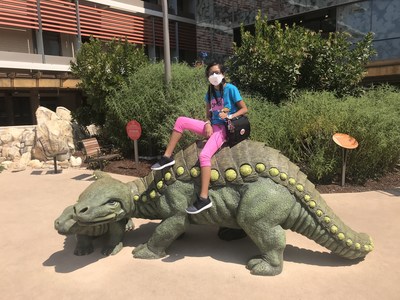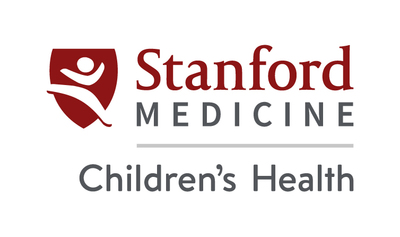Lucile Packard Children's Hospital Stanford appeals to FDA for permission to perform unusual surgery to save a 12-year-old girl
|
STANFORD, Calif., /PRNewswire/ -- When Lizneidy Serratos' mother took her to the hospital at 1 a.m. on August 4th, she thought wildfire smoke near the family's Reno home was causing the 12-year-old's struggle to breathe. But after a series of tests, doctors said Lizneidy's heart was failing.
"Her heart function was only at 10 percent," said Lizneidy's mom, Maricela Alvarado-Lazarit. "It was a shock." After an August 12 surgery at Lucile Packard Children's Hospital Stanford, Lizneidy became the youngest and smallest person in the country — and one of the smallest in the world — to receive the type of heart pump now keeping her alive. She was saved by heroic behind-the-scenes work by her doctors and nurses, who petitioned the US Food and Drug Administration for permission to use a medical device that had not yet been approved for children. They got a compassionate-use exemption in about 24 hours. "When Lizneidy came to us, she was very, very sick," said pediatric cardiothoracic surgeon Katsuhide Maeda, MD, who performed her surgery. Lizneidy had dilated cardiomyopathy, a leading cause of heart transplants in children. "She was vomiting and nauseated, and could not eat at all," said Maeda, who is also associate professor of cardiothoracic surgery at the Stanford University School of Medicine. "And she couldn't walk because her heart was so weak." Identifying the problem "I was criss-cross applesauce, with my head down at my feet," Lizneidy said. People with heart failure can often breathe better if they sleep sitting up, but Maricela did not yet know about the diagnosis. Alarmed, she woke Lizneidy and took her to the nearest emergency room. Doctors transferred Lizneidy to the pediatric intensive care unit at another Reno hospital, Renown Children's Hospital, which has a pediatric specialty care partnership with Stanford Children's Health. Then, Lizneidy was transferred by an emergency medical flight to Packard Children's. Lizneidy received medications that stabilized her for a few days. But her heart was not recovering. As in most cases of dilated cardiomyopathy, the physicians did not know why her heart failed. "It appeared she was getting worse and was going to need a ventricular assist device," said pediatric cardiologist Christopher Almond, MD, associate professor of pediatrics at the School of Medicine. A ventricular assist device is a surgically implanted pump that helps a patient's failing heart move blood through the body. Almond told the family Lizneidy would probably need a heart transplant, and that she would receive surgery to implant a pump that could keep her alive until a donor heart became available. The best pump However, the HeartMate 3 had one drawback. To implant it, Maeda needed to create a hole in Lizneidy's left ventricle, the largest pumping chamber in her heart, and suture a washer-like device called a sewing ring onto the heart to anchor the pump. But the sewing ring that had been approved by the FDA was too big for Lizneidy. At the time, a smaller ring was approved only in Europe. "The problem with the larger sewing ring is that Dr. Maeda would have had to sew across one of her most important coronary arteries," Almond said. In rare cases, heart pumps allow children's hearts to regain enough function to avoid a transplant. Closing the artery would have permanently severed the blood supply to part of Lizneidy's heart muscle, cutting off this possibility. "Because she had a chance of recovery, we didn't want to sacrifice the main artery supplying blood to her heart," Almond said. So, on Thursday, August 9, Almond began the process of asking the FDA for a compassionate-use exemption to allow the small sewing ring. He wrote a letter to the FDA and the device manufacturer, Abbott, requesting permission to use the smaller unapproved sewing ring; contacted Stanford's ethics team to get its permission for the unusual surgery; and arranged for another cardiologist to provide an independent second opinion to the FDA. On Friday, as hours ticked by and paperwork stacked up, people in several locations across the country — including FDA staff — stayed late at work to help. "The process for getting compassionate-use approval is a bit complex," Almond said, noting it can take days or weeks. But everyone recognized the urgency of Lizneidy's case. "The hospital, the FDA and the company did a phenomenal job supporting this medical request on such short notice." "Everybody was so good, keeping us informed of what was going on and what to expect," Maricela said. By 9 p.m. Pacific time on Friday, the approval was complete. In one more bit of serendipity, Almond learned that the small sewing rings — which were commercially available only in Europe — are manufactured 30 miles from Packard Children's, in Pleasanton, California. The company's representative told him "We've got three of them right here." The sewing ring arrived at the hospital Saturday morning. By evening, Lizneidy was getting worse again. It was time for surgery. Becoming a medical pioneer The pump made an enormous difference. Lizneidy's breathing tube was removed the next day, and she soon began eating again. "Having her just talking and laughing and asking for things was great," Maricela said. "When she started being able to get up, it felt like 'She's going back to normal.'" Since the surgery, the smaller sewing ring has received FDA approval for commercial use, enabling more patients to benefit from the device. Lizneidy's family is now staying at the Ronald McDonald House at Stanford. Lizneidy is receiving physical therapy to rebuild her strength and improve her ability to recover from a future heart transplant. Her medical team — which also includes pediatric cardiologist David Rosenthal, MD, professor of pediatrics at the School of Medicine, and nurse practitioner Jenna Murray — plans to monitor her for a few months before deciding whether to add her to the transplant waiting list. In the meantime, Lizneidy is relaxed and cheerful, attending seventh grade at the hospital school and taking in stride new challenges like swallowing lots of pills, which are intended to give her heart every opportunity to recover if it can. The battery pack for her heart pump is always at her side, housed in a tote bag she wears over her shoulder. "It's like an annoying best friend, always there," Lizneidy said. "But I'm OK with it." Media Contact: About Stanford Children's Health and Lucile Packard Children's Hospital Stanford Stanford Children's Health, with Lucile Packard Children's Hospital Stanford at its center, is the Bay Area's largest health care system exclusively dedicated to children and expectant mothers. As a top-ranked children's hospital by U.S. News & World Report, we are a leader in providing world-class, nurturing care and achieving extraordinary outcomes in every pediatric and obstetric specialty. Stanford Children's Health provides everything from specialty care to general pediatrics and can be accessed through more than 60 locations across Northern California and 100 locations in the U.S. western region. As the pediatric and obstetric teaching hospital for the world-renowned Stanford University School of Medicine, we're cultivating the next generation of medical professionals and are at the forefront of scientific research to improve children's health outcomes around the world. We are a nonprofit organization committed to supporting the community through meaningful outreach programs and services and providing necessary medical care to families, regardless of their ability to pay. Discover more at stanfordchildrens.org.
SOURCE Lucile Packard Children’s Hospital Stanford |


